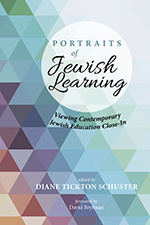These Jewish schools are getting it right
Researchers went in search of models of excellence in Jewish education. Here's what they found.

Several years ago, the Jack, Joseph, and Morton Mandel Center for Studies in Jewish Education encouraged and sponsored a number of scholars and practitioners in the field of Jewish education to find answers to this question.
Their findings are included in the recently published, “Portraits of Jewish Learning: Looking at Jewish Education Close-In.” Some of the approaches are cutting-edge. Others draw inspiration from ancient Jewish traditions.

The Mandel Center seeks to promote a deeper understanding of the purposes and practices of Jewish education. It was established in 2002 with the mission of inspiring Jewish educators and
Here are some of the schools and pedagogical methods discussed in “Portraits of Jewish Learning”:
Going Deeper, Together
In
As part of a pilot program, Orit Kent and Allison Cook, co-leaders of Pedagogy of Partnership, designed a
Over the course of eight weeks, the students worked in pairs to read and interpret biblical texts, such as the Jacob and Esau story. The text itself was regarded as the third member in the students’ partnership, so that “each partner, including the text, is a living resource that has something worthwhile to offer,” Kent and Cook write.
The kids received prompts to help them draw out each other's ideas, such as asking, “Can you say that in a different way or give an example?” or "What's your evidence?"
By the end of the course, the students made dramatic progress in their ability to work effectively and collaboratively to arrive at nuanced conclusions about the texts.
According to Kent and Cook, the kids were also able to “express an accompanying awareness that how one seeks to understand another person is connected to how we seek to understand our sacred texts.”
Innovative Hebrew Education
All too often students find learning Hebrew dull and laborious. They grow tired of rote memorization and repetitive assignments.
Rabbi Nicole Greninger, of Temple Isaiah in Lafayette, California, wondered, “Is there a better way to help kids feel enthusiastic about learning Hebrew?”
She and colleagues overhauled the curriculum so that Hebrew would be taught partly through movement. For example, a student might be asked to “point to the word Shabbat” or “dance over to the Pesach table.”
Another part of the new approach involved Hebrew Boot Camp where shortly before they become bar or bat mitzvah, students work for 12 weeks one-on-one with a mentor studying Hebrew. By the end, the kids can recognize all the Hebrew letters and vowel signs and sound out Hebrew words.
Finally, there’s
Confronting the Complexity of Israel
Matt Reingold, a teacher at TanenbaumCHAT, a non-denominational Jewish school in Toronto, wanted to teach his 12th-grade history class about the moral complexity of the Arab-Israeli conflict but wondered how that would affect their views of Israel. “I wanted to assess whether my twin goals — to teach a full history and to instill a love for Israel — could be achieved simultaneously,” Reingold writes.
He implemented a curriculum that focused on some of the most controversial events in Israeli history: the 1948 killing of Arabs by Jewish fighters in the village of Deir Yassin outside Jerusalem; the Israeli military’s role in the Sabra and Shatila massacre in Lebanon in 1982; and the negative treatment of Jewish Ethiopian immigrants in Israel in the 1980s and 1990s.
By the end of the class, all of the students remained committed to their Zionist beliefs. They felt they better understood the country. It now seemed like an actual country with good and bad aspects rather than an idealized, mythical place that didn’t seem real to them.
Helping Kids to Feel at Home in Their Community
When Jordana Schuster Battis and Rachel Happel started the after-school program Mayim Tamid in 2016, at Temple Beth Shalom in Needham, Mass., they wanted the k-5 students and teachers to feel at home and part of an extended family.
The classroom is furnished as a living room with a couch and play area. Students can wear slippers. Teaching occurs one-on-one around the snack table. The conversation is casual and doesn’t feel like a formal lesson.
The curriculum is project-based and hands-on, designed, Battis and
Students also perform chesed, or acts of
Categories: Humanities and Social Sciences, Research





